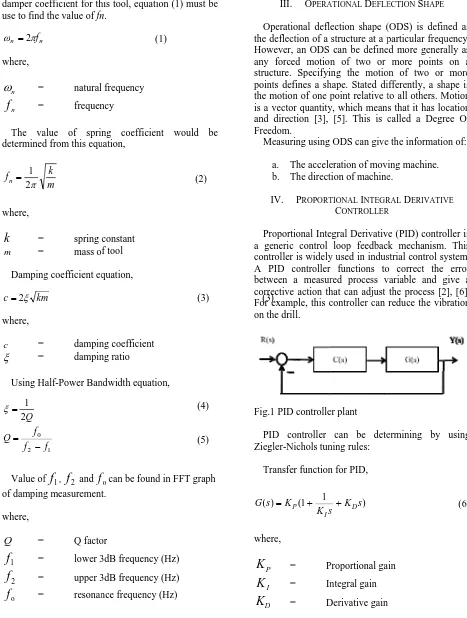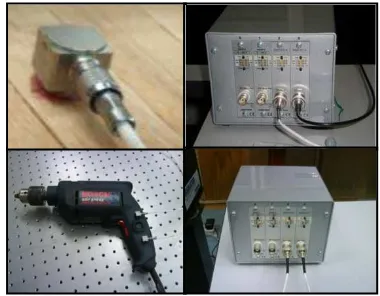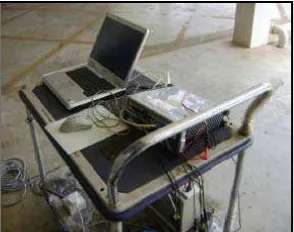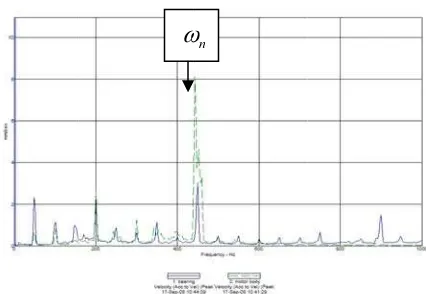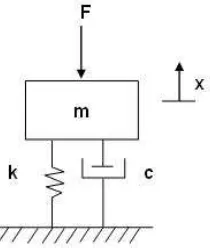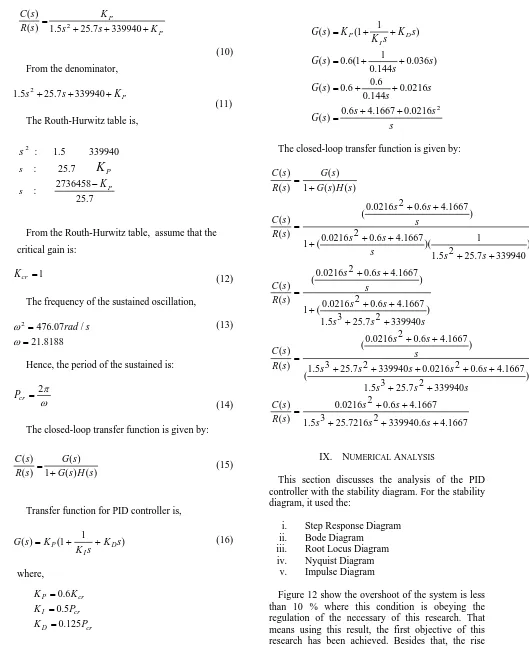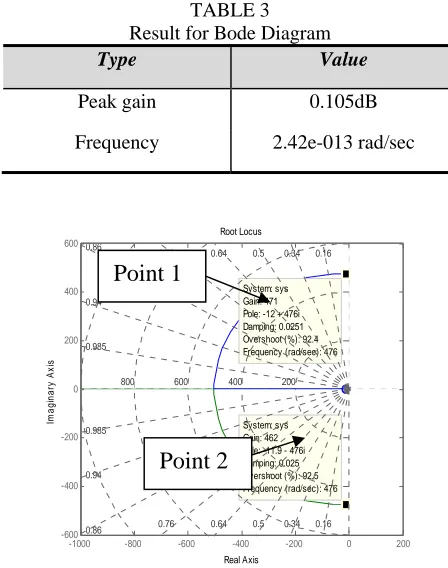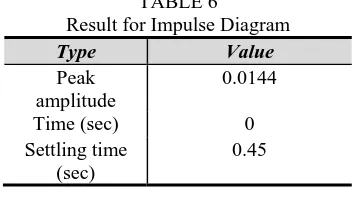International Journal of Mechanical & Mechatronics Engineering IJMME-IJENS Vol: 11 No: 02 7
112801-02-9494 IJMME-IJENS © April 2011 IJENS
I J E N S
PID Controller for Vibration Reduction and Performance Improvement of
Handheld Tools
M.A.Salim, A.Noordin, A.N.Ismail, F.Munir
Abstract-This paper proposes a PID Controller to mprove handheld tools performance and at the same time reduce vibration occurs during its operation. Two experiments has been setup to record vibration of handheld drill using accelerometer placed at certain points of the hand drill. Through experiment, the obtained data was analyzed using Fast Fourier Transform (FFT) and Operational deflection shape (ODS) technique and the data being verify which gives the natural frequency at 476.07Hz which is 5.7% higher that theoretical value. From the data the PID controller is designed and tunes using Ziegler Nichols method which gives peak amplitude at 0.0144 and settling time at 0.45s. From the result it is believed that this proposed controller can reduce the vibration and give good improvement to the handheld tool performance.
Key words: vibration, Fast Fourier transform, PID, Ziegler Nichols.
I. INTRODUCTION
Vibration is a phenomenon that produces by a tool during operating. Study on vibration gives many spaces to learn how vibration is exactly working. Level of vibration depends on the speed of tool during operation. If higher speed is given, higher vibration will occurs. Vibration gives so many benefit and destruction. In industry, vibration is useful for their operation. For example, massaging and therapeutic application.
Usage s is very popular among the builders. For instance, hand drill is very useful in order to simplify a hard works such as in engineering fields.
Manuscript received January 5, 2011. This research was funded by Faculty of Mechanical Engineering, Universiti Teknikal Malaysia Melaka, Malaysia.
M.A.Salim is with the Faculty of Mechanical Engineering, Universiti Teknikal Malaysia Melaka, Malaysia. (email: [email protected]).
A.Noordin is currently with Faculty of Electrical Engineering, Universiti Teknikal Malaysia Melaka, Malaysia. (email: [email protected]).
A.N.Ismail is with Faculty of Mechanical Engineering, Universiti Teknikal Malaysia Melaka, Malaysia.
F.Munir is with the Faculty of Mechanical Engineering, Universiti Teknikal Malaysia Melaka, Malaysia. (email: [email protected]).
When talking about hand powered portable machines, the current issues that always questioned and argued are how safe these machines to human body in term of physical and internal. A part of the issues concerning the operator safety is the transmission of vibration to the hand and arm.
In hand powered portable machines, the vibration is considered as a kinetic energy and a potential energy. It means vibration system is able to store and release energy. Hartog et.al was argued that vibration refers to mechanical oscillations about an equilibrium point [1], [2], [3]. The oscillations are in periodic such as the motion of a pendulum or random such as the movement of the tools.
Hand powered portable machines is an arm instrument that use hand as a support system during the operation. The feature of this instrument is it has a handle which is specially made for the convenient and safety of the users. Among the tools that are commonly used as handheld are drill, grinder, hammer, saw, axe and etc. Each tool has a handle made either on top, front or rear. For example, chainsaw has a handle on top and rear of the tool therefore it can be function well doing the cutting. Meanwhile for a drill, its handle is at the front and the rear where the rear handle is the main and the front handle act as it supporter.
Rear handle is very important for this kind of hand powered portable machines. The function of the rear handle is to control the movement of the tool. Without the rear handle, it is difficult to control the tools during operating. Vibration at the rear handle is higher compare to the other handles. This is because rear handle is commonly nearer to the motor.
II. FAST FOURIER TRANSFORM
The invention of the Fast Fourier transform (FFT) algorithm finally leads for rapid and prevalent application of experimental technique in structural dynamics. With FFT, frequency responses of a structure can be computed from the measurement of given inputs and resultant responses.
Intern
damper co use to find
where,
n
=n
f
=The va determined where,
k
= m = Damping where,c =
=Using H
Value of of damping
where,
Q =
1
f
=2
f
=0
f
=km c2
2 0 2 1 f f f Q Q n
n f
2
fn 2 1 national Journa efficient for th the value of fn
natural
frequen
alue of sprin d from this equ
spring mass o
g coefficient eq
dampin dampin
Half-Power Ban
f
f
1,f
2 andf
g measurement Q facto lower 3 upper 3 resonan m 1 f m k
al of Mechanic
11 his tool, equati
n. ( l frequency ncy ng coefficien uation, constant f tool quation, ng coefficient ng ratio ndwidth equatio 0
f
can be foundt.
or
3dB frequency
3dB frequency
nce frequency
al & Mechatro
12801-02-9494 IJMME on (1) must be
1)
nt would be
(2) (3) on, (4) (5)
d in FFT graph
(Hz)
(Hz)
(Hz)
onics Engineeri
E-IJENS © April 2011 e e (3) Op the d How any struc point the m is a v and Freed Me a b I Pro a ge contr A P betw corre For e on th Fig.1 PID Ziegl Tra wher P
K
IK
DK
) (s G ing IJMME-IJE IJENS )III. OPERA
perational defl deflection of a wever, an ODS
forced motion cture. Specifyi
ts defines a sh motion of one p
vector quantity direction [3], dom.
easuring using
a. The accele
b. The direct
IV. PROPORT
oportional Inte eneric control
roller is widely PID controller ween a measur ective action th example, this c he drill.
1 PID controlle
D controller ler-Nichols tun
ansfer function
re,
= P
= In
= D
1 1 ( ) s K K I P
ENS Vol: 11 N
ATIONAL DEFLE
ection shape ( structure at a p
can be define n of two or ing the motio hape. Stated di point relative t y, which mean
[5]. This is c
ODS can give
eration of mov tion of machine
TIONAL INTEGR
CONTROLLER
egral Derivativ loop feedbac y used in indus r functions to red process v hat can adjust controller can
er plant
can be dete ning rules:
n for PID,
Proportional ga ntegral gain Derivative gain ) s K s D
No: 02
I J
ECTION SHAPE
(ODS) is defin particular frequ ed more genera more points on of two or ifferently, a sh
to all others. M s that it has lo called a Degr
e the informatio
ing machine. e.
RAL DERIVATIV R
ve (PID) contro ck mechanism
strial control sy o correct the variable and g
the process [2 reduce the vib
ermining by
ain
n
8
E N S
International Journal of Mechanical & Mechatronics Engineering IJMME-IJENS Vol: 11 No: 02 9
112801-02-9494 IJMME-IJENS © April 2011 IJENS
I J E N S
V. ZIEGLER-NICHOLS METHOD
Using only proportional feedback control:
i. Reduce the integrator and derivative gains to 0
(KI and KD equal to 0).
ii. Increase KP from 0 to some critical value Kp
= Kcr at which sustained oscillations occur. If this does not occur, then another method has to be applied.
iii. Note the value Kcr and the corresponding
period of sustained oscillation, Pcr.
TABLE 1
PID CONTROLLER TYPES
PID type
P
K
K
IK
DP 0.5 Kcr
0PI 0.45 Kcr
2
.
1
cr
P
0PID 0.6 Kcr
2
cr
P
8
cr
P
Past research has makes a comparison for all three gains; proportional (KP), integral (KI) and derivative (KD) scheduling algorithms for a variable gain and first order time constant including time delay process. These three algorithms consist of gain scheduling (GS), fuzzy gain scheduling (FGS), and model based fuzzy gain scheduling (MFGS). GS is a gain scheduling algorithms with hard switching. FGS and MFGS are simply different ways of interpolating parameters in a gain scheduled controller. The MFGS interpolation is linear with the inverse of the controller gain, and linear with both integral and derivative time [2].
The nonlinear PID controller based on a desired response to a step set point change had been done by Zhao et.al (1993). Initially, a large control signal is desired to achieve a fast rise time, therefore the PID controller gain is large and the derivative time is small.
As the set point reach, a small controller gain is desired, therefore the overshoot is not too large. The fuzzy rules change the controller parameters based on the error and its rate of change at each time increase. [2], [3], [4].
The approach in 1992s was modified by other researchers to include dead band in between the PID controller regions where the controller parameters are linearly interpolated. Applications of these three region is designed to control a simulated pH system
and show better results than a standard fixed PID controller and a rigid gain scheduler [2], [3].
Qin et.al (1995) has developed a controller logic based for PID controller for a pH process. From his simulation study, the result shows three regions designed is better than a single region designed [2].
VI. EXPERIMENT SETUP AND RESULT
A. Setup for FFT experiment
In this experiment, the accelerometers would be placed at the rear handle of the drill. Result from this experiment will give the information about vibration that occurs at the handle when the machine is running. This method can identify which area gives the highest level of vibration.
For this experiment, the material that need to be tested is BOSCH hand drill type GSB 550RE. The specification of the drill is shown below:
1. Power input = 550W
2. Impact rate = 48000 rpm
3. Weight = 1.5 kg
4. Electric motor, number of poles = 2
5. Variable speed power drill = 3000 rpm
6. Blower = 39 vanes
7. Bevel gear reduction N1 = 4/N2 = 37
8. Rolling element bearings
9. Cylindrical roller on gear box, 12
rollers/pins
10. Impact ratchet = 16 serrations
The equipments used are accelerometer, impact hammer with green tip, software, PC data acquisition system, amplifier (4 channels), stabilize table, and rubber support. The accelerometer function is to sense or detect the vibration made by the drill. Fig. 2 and 3 shows the equipments for this experiment.
International Journal of Mechanical & Mechatronics Engineering IJMME-IJENS Vol: 11 No: 02 10
112801-02-9494 IJMME-IJENS © April 2011 IJENS
I J E N S
Fig. 3 Result in FFT
(a) Equipment setup
(i) Put the drill on the top of the stabilize table.
Use the rubber support to make sure the drill is not moving after the switch on.
(ii) Then setup the stabilize table. Open the hydraulic machine and set the rubber support at the surface of the table.
(b) Fast Fourier Transform (FFT) Analyzer Setup
(i) Firstly, setup the amplifier channel. Set
channel 3 with accelerometer wire for point 1 and channel 4 with accelerometer wire for point 2.
(ii) Then attached the accelerometers at the rear
handle of drill using thin layer of wax. Make sure the accelerometer is perpendicular (90 degree) to the drill surface.
(iii)Make sure all cables are connected. Turn on
the constant power supplies for the accelerometer.
(c) Data acquisition
(i) Once the drill is on, the measurement is
taking by clicking the measure button.
Fig. 4 DEWEsoft software
(ii) After a while, click the stop button and store
the result. The result can be seen by clicking the “Analyse” button. From there, select the filename for this experiment and The Fast Fourier Transform (FFT) graph will be shown.
B. Setup for ODS experiment
Operational Deflection Shape is another method used to measure the vibration level on the rear handle
of the hand drill. Six accelerometers will be placed on the handheld tool.
This experiment involved 3 important equipments:
i. 6 units of 3-axial accelerometer (KISTLER)
Collect the response data in X, Y and Z direction.
ii. PAK Muller-BBM FFT Analyzer
Signal from accelerometer are connected to the channel analyzer and then it would processed as required.
iii. Post-processing modal software (ME’ scope
VES).
Process the data to identify the modal parameter, execute the vibration criteria, and animate the mode shapes, and Operational Deflection Shape (ODS).
Fig. 5 Experiment setup for Operational Deflection Shape (ODS)
The procedure of this experiment is:
a. All the major forcing frequencies for the
synchronous forcing at x1, x2, x3 RPMs for all components such as gear mesh frequencies, bearing frequencies, ratchet impact frequencies and all components need to be calculated.
b. The analyzer must be set to a suitable
maximum frequency based on the forcing frequencies.
c. Then, the accelerometer placed at the flat
spot on the drill. When the drill with zero loads, the drill is run and the speed is locked at the setting. The Fast Fourier Transform spectrum where it is at least 10 averages is measured to obtain no load baseline conditions.
d. The spectrum can be stored.
e. The Fast Fourier Transform spectrum on the
Interna
VII. E
A. Result f
Fig. 6 Vibr
Fig. 7 Vibr
In Figur occurred a higher vibr spring coef
B. Verifica (FFT)
Fig. 8 The (FFT)
ational Journal
EXPERIMENT R for Fast Fourie
ration at Point
ration at point
re 6 and 7, at frequency 4
rations than p fficient can be
ation the data fr
eoretical data f
of Mechanical
11 RESULTS AND D
r Transform
1 for first mea
2 for first mea
the highest v 476.07Hz. Po oint 1. Using
calculated.
from Fast Four
from Fast Four
n
l & Mechatron
12801-02-9494 IJMME DISCUSSION
asurement
surement
vibration level int 2 produce this value, the
rier Transform
rier Transform
nics Engineerin
E-IJENS © April 2011 l
e e
m
Fig for t frequ exper from
Perce
= Ex
= 476
= 5.7
Fig. 9
C. Re
Th hand meas
ng IJMME-IJEN
IJENS
gure 8 shows th this experime uency is 450 H
riment has be m the experimen
entage of error
xperiment data Theore
6.07 – 450.00 x 450.00
7%
9 Damping me
Resonance
Upper 3 dB
Lower 3 d
esults for Oper
he acceleration dle of the ha sured and plott
NS Vol: 11 No
he reference d ent. Suspected Hz. Percentag een calculated nt.
rs is
– theoretical d etical data
x 100%
easurement
e frequency,
f
B frequency,
f
dB frequency,
f
rational Deflec
of the six nod and drill has
ed.
o: 02
I J
ata (theoretica d value for n ge of errors fo d to verify the
data x 100%
Hz
f
0
8
.
62
Hz
f
2
8
.
77
Hz
f
1
8
.
46
ction Shape
dal points of th been succes
11
E N S
l data) natural or this e data
z
z
z
International Journal of Mechanical & Mechatronics Engineering IJMME-IJENS Vol: 11 No: 02 12
112801-02-9494 IJMME-IJENS © April 2011 IJENS
I J E N S
Fig. 10 Acceleration of the rear handle plotted in MATLAB
The acceleration of six nodal points of the rear handle of the hand drill has been measured and plotted in MATLAB. The graphs show that the highest vibration level occurred at point 2. Compare to other the graphs, point 2 produces the highest acceleration which mean the higher vibration level occurred at this point. High acceleration will gives more vibration to the drill.
This point is actually the main area where the user grip the handle while operating the hand drill. This area must have the safety precaution in order to give more safety for users and also to give longer lifetimes to the tool.
VIII. APPLICATION OF PROPORTIONAL INTEGRAL
DERIVATIVE CONTROLLER
Fig. 11 Schematic diagram for the plant
Equation of motion for this system is,
(7)
The transfer function for the system is,
(8)
Use the second method of Ziegler-Nichols tuning rules,
I
K
andK
D
0
(9)
The final closed loop transfer function is,
F kx x c x m
F kx cu ma
F f f ma
ma f f F
ma F
s d
s d
. ..
3 2
10 94 . 339 7 . 25 5 . 1
1 )
(
s s
International Journal of Mechanical & Mechatronics Engineering IJMME-IJENS Vol: 11 No: 02 13
112801-02-9494 IJMME-IJENS © April 2011 IJENS
I J E N S
(10)
From the denominator,
(11)
The Routh-Hurwitz table is,
2
s : 1.5 339940
s : 25.7
K
Ps :
7 . 25
2736458KP
From the Routh-Hurwitz table, assume that the
critical gain is:
(12)
The frequency of the sustained oscillation,
(13)
Hence, the period of the sustained is:
(14)
The closed-loop transfer function is given by:
(15)
Transfer function for PID controller is,
(16) where, s s s s G s s s G s s s G s K s K K s G D I P 2 0216 . 0 1667 . 4 6 . 0 ) ( 0216 . 0 144 . 0 6 . 0 6 . 0 ) ( ) 036 . 0 144 . 0 1 1 ( 6 . 0 ) ( ) 1 1 ( ) (
The closed-loop transfer function is given by:
1667 . 4 6 . 339940 2 7216 . 25 3 5 . 1 1667 . 4 6 . 0 2 0216 . 0 ) ( ) ( ) 339940 2 7 . 25 3 5 . 1 1667 . 4 6 . 0 2 0216 . 0 339940 2 7 . 25 3 5 . 1 ( ) 1667 . 4 6 . 0 2 0216 . 0 ( ) ( ) ( ) 339940 2 7 . 25 3 5 . 1 1667 . 4 6 . 0 2 0216 . 0 ( 1 ) 1667 . 4 6 . 0 2 0216 . 0 ( ) ( ) ( ) 339940 7 . 25 2 5 . 1 1 )( 1667 . 4 6 . 0 2 0216 . 0 ( 1 ) 1667 . 4 6 . 0 2 0216 . 0 ( ) ( ) ( ) ( ) ( 1 ) ( ) ( ) ( s s s s s s R s C s s s s s s s s s s s s R s C s s s s s s s s s R s C s s s s s s s s s R s C s H s G s G s R s C
IX. NUMERICAL ANALYSIS
This section discusses the analysis of the PID controller with the stability diagram. For the stability diagram, it used the:
i. Step Response Diagram
ii. Bode Diagram
iii. Root Locus Diagram
iv. Nyquist Diagram
v. Impulse Diagram
Figure 12 show the overshoot of the system is less than 10 % where this condition is obeying the regulation of the necessary of this research. That means using this result, the first objective of this research has been achieved. Besides that, the rise
P P K s s K s R s C 339940 7 . 25 5 . 1 ) ( ) ( 2 P K s
s 25.7 339940 5 . 1 2 1 cr K 8188 . 21 / 07 . 476 2
rad s
2 cr P ) ( ) ( 1 ) ( ) ( ) ( s H s G s G s R s C cr D cr I cr P P K P K K K 125 . 0 5 . 0 6 . 0 ) 1 1 ( )
( K s
s K K s G D I
P
International Journal of Mechanical & Mechatronics Engineering IJMME-IJENS Vol: 11 No: 02 14
112801-02-9494 IJMME-IJENS © April 2011 IJENS
I J E N S
time of this system is 1.54 sec, peak amplitude is 1.01, overshoot is 0 %, time is 5e005 and the final value is 1.
Fig 12 Step Response diagram for PID controller
TABLE 2
Result for Step Response diagram
Type Value
Rise time 1.82e005 sec
Peak amplitude 1.01
Overshoot 0%
Time 5e005 sec
Settling time 3.23e005 sec
Final value 1
In Figure 13, the result describes the natural frequency of the system. The frequency of the system is 2.42e-013 rad/sec where this frequency refers to the natural frequency. The peak gain of this system is 75.6 dB.
Figure 14 shows two section of Root Locus diagram. In the diagram, the firstly is point 1 where the gain is 471 and the pole is -12+476i. At the second point, the gain is 462 and the pole is -11.9+476i.
Fig. 13 Bode Diagram for PID controller
TABLE 3 Result for Bode Diagram
Type Value
Peak gain 0.105dB
Frequency 2.42e-013 rad/sec
Fig. 14 Root Locus diagram for PID controller
Step Response
Time (sec)
Am
pl
itude
0 0.5 1 1.5 2 2.5 3 3.5 4 4.5 5
x 105 0
0.1 0.2 0.3 0.4 0.5 0.6 0.7 0.8 0.9 1
System: sys Peak amplitude >= 1.01 Overshoot (%): 0 At time (sec) > 5e+005 System: sys
Settling Time (sec): 3.23e+005
System: sys Rise Time (sec): 1.82e+005
10-1 100 101 102 103 104
-135 -90 -45 0 45 90
Ph
a
s
e
(
d
e
g
)
Bode Diagram
Frequency (rad/sec) -120
-110 -100 -90 -80 -70 -60 System: sys
Peak gain (dB): 0.105 At frequency (rad/sec): 2.42e-013
M
a
gn
itu
d
e (
d
B)
-1000 -800 -600 -400 -200 0 200
-600 -400 -200 0 200 400 600
0.5 0.64 0.76 0.86
0.94
0.985
0.16 0.34 0.5 0.64 0.76 0.86
0.94 0.985
200 400 600 800
System: sys Gain: 462 Pole: -11.9 - 476i Damping: 0.025 Overshoot (%): 92.5 Frequency (rad/sec): 476 System: sys Gain: 471 Pole: -12 + 476i Damping: 0.0251 Overshoot (%): 92.4 Frequency (rad/sec): 476
0.16 0.34 Root Locus
Real Axis
Im
a
g
inar
y
Ax
is
Point 1
International Journal of Mechanical & Mechatronics Engineering IJMME-IJENS Vol: 11 No: 02 15
112801-02-9494 IJMME-IJENS © April 2011 IJENS
I J E N S
TABLE 4
Result for Root Locus diagram
In Figure 15, phase margin in this diagram is at -180 deg. The delay margin at this point is infinity and the frequency is 0 rad/sec.
Fig. 15 Nyquist diagram for PID controller
TABLE 5 Result for Nyquist diagram
Type Value
Phase margin (deg) -180
Delay margin (sec) Infinity
Frequency 0 rad/sec
Closed loop stable Yes
In Figure 16, peak amplitude of the system is 0.0144 at time 0 sec. The settling time for the plant is 0.45 sec.
Fig. 16 Impulse Diagram for PID controller
TABLE 6
Result for Impulse Diagram
Type Value
Peak amplitude
0.0144
Time (sec) 0
Settling time (sec)
0.45
X. RECOMMANDATION
For the further work of this study, comparisons with the implementation of this PID controller to the same system are necessary to look into a different condition of analysis with simulation analysis and experimental analysis. In this comparison, it can give a more accurate analysis within using software and hardware where it can handle the system to dampen the vibration. Finally, the study using software and hardware is needs to look the performance on how the improvement using PID controller into that system.
XI. CONCLUSION
Application of controller into the plant reduces the level of vibration on the handheld tools. Several types of controller were tested in order to stabilize the plant. All controllers were test one by one and lastly, the comparison for each controller will be discussed. PID controller was chosen among those controllers depend on its performance in the system of handheld tool.
The Ziegler Nichols is very useful tuning rules where this method can tune the PID controller for give a stable performance when apply this controller to the plant using the simulation in MATLAB
Nyquist Diagram
Real Axis
Im
agi
nar
y
Ax
is
-1 -0.8 -0.6 -0.4 -0.2 0 0.2 0.4 0.6 0.8 1 -0.5
-0.4 -0.3 -0.2 -0.1 0 0.1 0.2 0.3 0.4 0.5
System: sys Phase Margin (deg): -180 Delay Margin (sec): Inf At frequency (rad/sec): 0 Closed Loop Stable? Yes 0 dB
-20 dB -10 dB
-6 dB -4 dB
-2 dB
20 dB 10 dB
6 dB4 dB 2 dB
Impulse Response
Time (sec)
Am
pl
itude
0 0.1 0.2 0.3 0.4 0.5 0.6 0.7
-0.015 -0.01 -0.005 0 0.005 0.01 0.015
System: sys Peak amplitude: 0.0144 At time (sec): 0
System: sys Settling Time (sec): 0.45
Point 1 Point 2
Gain 471 Gain 462
Pole -12+476i Pole -11.9+476i
Damping 0.0251 Damping 0.025
Overshoot 92.4% Overshoot 92.5%
Frequency 476 rad/sec
International Journal of Mechanical & Mechatronics Engineering IJMME-IJENS Vol: 11 No: 02 16
112801-02-9494 IJMME-IJENS © April 2011 IJENS
I J E N S
Software. Finally the objective of this research be achieved where to reduce the vibration and at the same time give a good performance to handheld tool.
REFERENCES
[1] Hartog, Den, “Mechanical Vibrations”, Dover Publications, ISBN 0-486-647854, 1985
[2] M.A.Salim, “Design a control system to dampen the vibration in a building like structure”. Universiti Teknikal Malaysia Melaka: B.Eng Thesis, 2006.
[3] M.F Hassan, M.H Zohari, M.A Salim and C.K.E Nizwan. 2009. Identification of Vibration Level on Rear Handle of the Handheld Tool Using Operational Deflection Shape (ODS). Proceeding of ICORAFSS 2009. 90-94, 2009.
[4] Wen Tan, “Robust Controller Design and PID Tuning for Multivariable Process”, North China Power Electric University, 1996.
[5] Brian J. Schwarz & Mark H. Richardson, “Introduction to Operating Deflection Shapes”, 1999.
